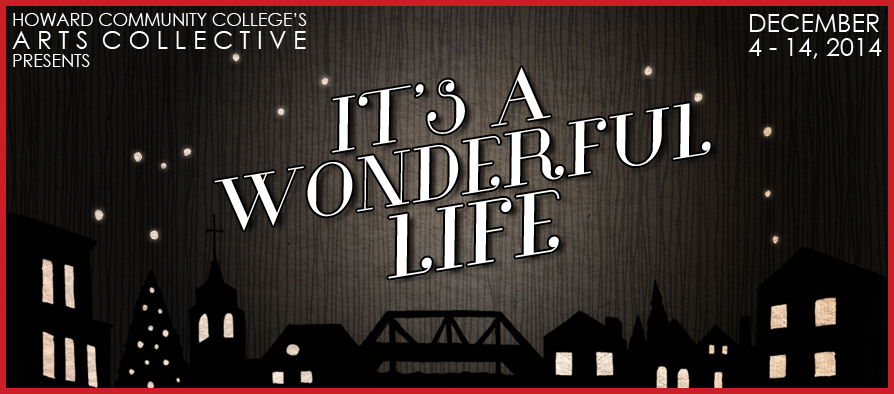No man is a failure who has friends. At this festive time of year it is easy to lose sight of such a simple message among all the decorations and holiday events. Howard Community College’s Arts Collective reminds us of the true joys of Christmas with their resplendent production of It’s A Wonderful Life. Directed by Gareth Kelly and Anthony Scimonelli, this heartwarming classic is reimagined to the stage in a most spectacular fashion. With a great deal of the classic characters and the tried and true storyline that melts hearts for the holidays, HCC Arts Collective invites audiences everywhere to celebrate how wonderful life truly is.
Scenic Designer Jeff Harrison has created a masterpiece. At first a deceptively simple gray set, closer inspection reveals Harrison’s brilliance as each of the little window and door seams are noticed. Harrison’s set is like a pop-up book adventure waiting to happen; each square ready to reveal a fun and fantastical Christmas scene behind it. In a sense it’s like an advent calendar of old; the eager audience pulls back the tab with their minds as the scenes unfold and behind each one awaits magic. This is only a portion of the mystical spectacle laid into the design work of this production.
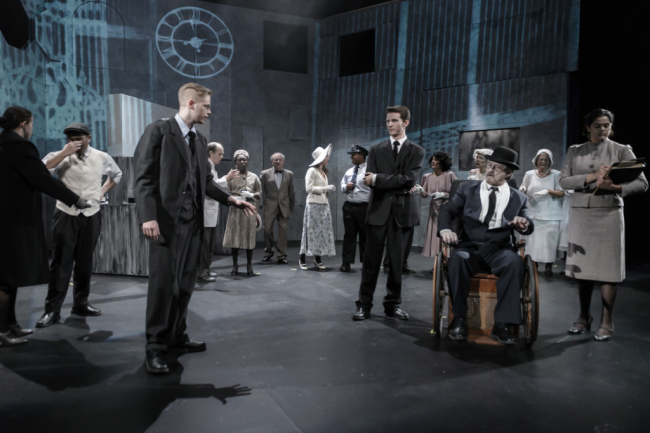
Foreground: Noah Bird (George Bailey), Adam Czarnecki (Mr. Potter’s Body Guard), Gary Grabau (Mr. Potter), Abigail Prevaiz (Mr. Potter’s Secretary)
Background: Taylor Prunell (Miss Carter), Diego Esmolo (Mr. Martini), William Stanley III (Uncle Billy), T. Naomi Muwowo (Miss Andrews), Bruce Leipold (Mr. Gower), Megan Abdo (Violet Peterson), Brandon W. Love (Bert), Terri Laurino (Ma Bailey), Ilene Chalmers (Aunt Tilly), Kathryn Marshall (Mrs. Hatch). Bruce Press Photography
Harrison’s simplicity enables Digital Scenographer Riki Kim to immerse the audience in the classic film. The iconic town of Bedford Falls is projected straight back onto Harrison’s set for various scenes throughout the performance. Kim’s ingenious use of scenes from the film blended with other rich fulfilling images sets the technical design work of this production miles above any other this time of year. The opening bridge scene alone with George Bailey standing atop the stairs and the bridge projected across the background is so striking; the atmosphere of the stage is crackling with theatrical magic. Kim works closely with Sound Designer Kevin Hill to create fusions of scenic beauty complete with soundscapes to underscore them.
Hill has exceptional timing with his sound work; aligning the shattered glass with the moving images in Kim’s designs for iconic scenes like making wishes and breaking windows at the Old Granville House. Working in tandem with Lighting Designer Lynn Joslin, Hill creates an enchanting thematic effect for the initial and subsequent arrival of Clara Oddbody, George’s guardian angel. Hill and Joslin combine blinking lights with shimmering sound; an angelic notion that makes her appearances whimsical and a little odd, the perfect fit for an angel second class. This is just one of dozens of magical moments peppered throughout the production for which Joslin and Hill are responsible. The overall aesthetic of the show is pleasing beyond compare compliments of the four aforementioned designers.
In keeping with a tribute to the classic black and white film, Costume Designer Shannon Maddox outfits the company in a monochromatic grayscale. The occasional hint of red where appropriate— like Clara’s scarf or Violet’s dress during the “Pottersville” scene— offsets the black and white color scheme with a hint of holidays. These gray tones blend against the background and enhance the overall visual experience of the audience as their imaginations reconcile what they are currently seeing with the way they remember the film.
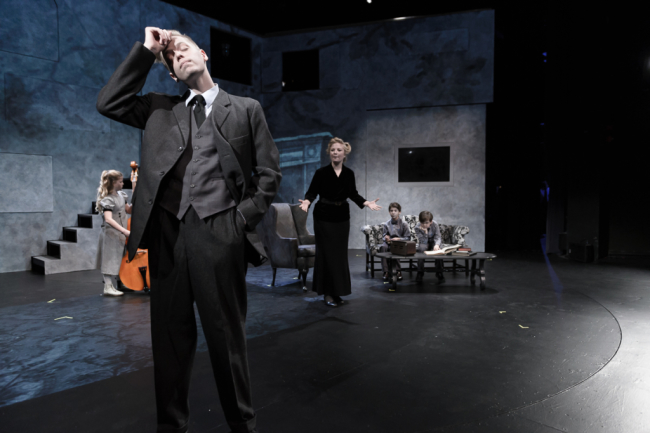
Directors Gareth Kelly and Anthony Scimonelli are making bold choices between their innovative and impressive design concepts and their curious casting choices. There is no dodging the issue that Scimonelli and Kelly have rewritten history by casting a female actor in the role of Clarence Oddbody, AS2 and are now calling her Clara. As strange and bold a choice this is, Emma K. McDonnell delivers the part exceptionally. Her quirky off-kilter mannerisms, combined with hints of physical shtick juxtaposed against her naïve sincerity results in a delightful portrayal that tugs at the heartstrings when she is encountered. McDonnell is bubbly and aloof in a pleasant and peculiar fashion, delivering the character of Clara to the audience in such a way that it is impossible to dislike her.
Cameo characters like Sam Wainwright (Hudson Mohler) and Violet Peterson (Meghan Abdo) have fleeting appearances but their portrayals resonate throughout the performance. Mohler appears only once in one of the clever pop-out hatches at the bottom right of the back of the stage but his brief phone exchange is witty and grounded in New York City savoir-faire. Abdo, as the sultry, albeit mild, Violet, transitions her character from her Bedford Falls scenes to her Potterville scene smoothly and her genuine gentle nature at the end of the performance is worth recognizing.
Ma Bailey (Terri Laurino) is an iconic representation from the film who stays almost true to all of her dialogue in the movie. Laurino is the spitting image of the slightly aged but still kindhearted matron. The careworn love she delivers to her son earlier in the performance creates a sharp contrast to the bitter biting remarks swapped with him during the Potterville scene. The same can be said for Mr. Gower (Bruce Leipold.) Wild and rash during his scene with Young George (Graham Rifkin) he mellows for other scenes in present time, and is a somber pitiable mess during his Potterville scene.
Bert (Brandon W. Love) and Ernie (Scott Lichtor) bring a bantering camaraderie to the scene and add hints of hilarity throughout in the few scenes in which they are featured. Uncle Billy (William Stanley III) is a bit mild at first, but by the time he spirals into his madness near the end of the production both his physicality and frazzled vocal delivery are harried into a frenzy and truly engaging.
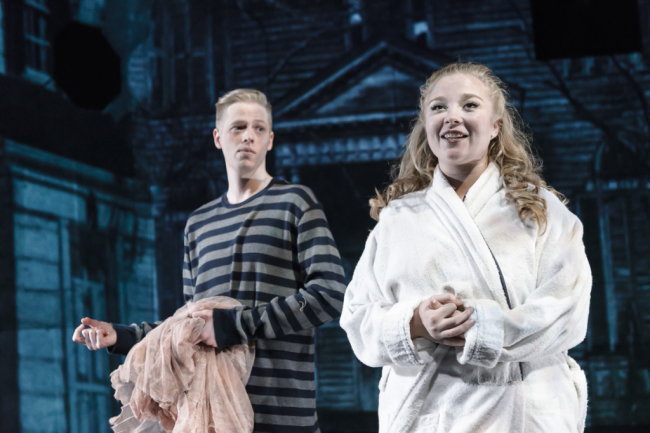
Mary Hatch (Rachel Bailey) and George Bailey (Noah Bird) have the show’s focus cast upon them. Bailey, as the starry-eyed young girl who falls head over heels in love with George, delivers a brilliant performance of the character. Not conforming to the expectations created by the film, Bailey creates her own dreamy version of Mary. The most impressive and responsive scene she delivers is late in the performance when George begins to bash Mrs. Welsh on the phone over Zuzu’s cold. The facial responses and her silent reactivity in that scene are honestly compelling and feel realistic beyond compare.
The chemistry between Bailey and Bird, particularly during the initial Sam Wainwright phone call, is dazzling. Like little twinkling snowflakes, their eyes light up when they play scenes together and the well-remembered “Buffalo Gals” post-swimming pool disaster scene is a touching and tender moment shared between two actors who truly grasp the notion of young lovebirds.
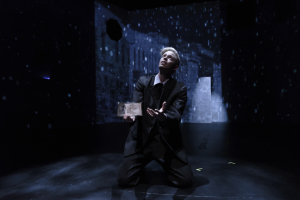
Bird, as the protagonist, understands how to balance his portrayal of George as a creation all his own with hints of homage to Jimmy Stewart’s original conception of the role. At times his anger seems unfathomable; the George Bailey America has come to know and love would never bark at his children in that fashion, but therein lays the brilliance of his portrayal— honest emotions explored at new heights. When Bird drops to his knees in one of the final scenes before Clara’s intervention, the harrowing expressions upon his face are both raw and revealing.
This production is wonderful, there’s no better word for it. The performances blend well against the technological spectacle and the overall concepts of blending the classic film with the live stage play are truly unique and inviting. Do not miss your chance to see Frank Capra’s story like you’ve never seen it before.
Running Time: 1 hour and 45 minutes with one intermission
It’s A Wonderful Life plays through December 14, 2014 at the Howard Community College’s Arts Collective, in the Smith Theatre of The Horowitz Visual and Performing Arts Center— 10901 Little Patuxent Parkway in Columbia, MD. For tickets call the box office at (443) 518-1500 or purchase them online.

